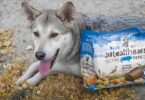Picture this: You’re enjoying a taco night with family, and your furry friend gazes up, hoping for a bite of that soft flatbread. Many pet owners face this moment, wondering if sharing a small piece of tortilla is safe or risky.
Tortillas, a staple in Mexican cuisine, are typically made from cornmeal or wheat flour. These ingredients alone aren’t toxic to pets. However, store-bought versions often contain added salt or preservatives, which may cause digestive issues in sensitive animals.
Understanding a pet’s nutritional needs is crucial. While whole grains and fiber in homemade tortillas offer some benefits, overfeeding can lead to weight gain or nutrient imbalances. Moderation remains essential, as treats should never replace balanced meals.
This guide explores how tortillas affect canine health, safe serving practices, and healthier snack alternatives. By evaluating both risks and benefits, pet parents can make informed choices that prioritize their companion’s well-being.
Understanding Tortillas and Their Ingredients
Breaking down the components of everyday foods helps pet owners prioritize their companion’s well-being. Tortillas, a versatile staple in many kitchens, consist of simple elements. However, their nutritional profile varies based on preparation methods and added ingredients.
What Are Tortillas Made Of?
Traditional tortillas contain three primary ingredients: cornmeal or wheat flour, water, and salt. Corn-based versions are gluten-free and rich in fiber, while wheat tortillas offer higher protein content. Homemade recipes often avoid additives, but store-bought options may include preservatives or excess sodium.
Nutritional Components: Flour, Corn, and Salt
Flour provides carbohydrates for energy, but overconsumption can contribute to weight gain in less active pets. Corn delivers antioxidants like lutein, supporting eye health. Salt enhances flavor but should remain minimal to avoid dehydration or kidney strain.
Portion control matters. While small amounts of plain tortillas rarely harm healthy animals, frequent feeding disrupts balanced diets. Always check labels for hidden seasonings or oils that might irritate sensitive stomachs.
The Nutritional Breakdown: Carbs, Fiber, and Proteins for Dogs
Balanced nutrition relies on three key elements: carbohydrates for energy, fiber for digestion, and proteins for bodily functions. These components work together to support a pet’s vitality, but their sources and proportions matter.
Benefits of Dietary Fiber and Whole Grains
Fiber from whole grains like corn helps regulate bowel movements. It absorbs water to soften stools, reducing constipation risks. For pets with sensitive stomachs, moderate fiber intake can stabilize digestion without causing bloating.
Corn-based ingredients also provide antioxidants. These compounds combat free radicals, supporting long-term cellular health. However, grain-heavy foods shouldn’t dominate meals, as excessive fiber may hinder nutrient absorption.
Role of Proteins and Vitamins in Canine Health
Proteins from flour and corn aid muscle repair and immune responses. Corn contains amino acids like leucine, which promotes tissue growth. Flour offers B vitamins that convert food into usable energy.
While these nutrients exist in tortillas, they’re not tailored for pets. Store-bought versions often lack optimal ratios. For example, sodium levels might outweigh benefits. Always pair occasional treats with protein-rich meals like lean meats or eggs.
Can Dogs Eat Tortillas: Evaluating the Health Effects
Pet owners often wonder how common human foods impact their companion’s well-being. While some ingredients offer nutritional value, others may pose hidden risks. Understanding these effects helps balance occasional treats with long-term health priorities.
Energy Support and Digestive Advantages
Plain versions provide carbohydrates for quick energy bursts during active days. The fiber content in corn-based options aids digestion by promoting regular bowel movements. This can benefit pets with occasional constipation when given sparingly.
Whole grains also deliver B vitamins, supporting metabolic functions. However, these benefits diminish if treats replace balanced meals. Portion control ensures snacks complement—not compromise—daily nutrient intake.
Caloric Concerns and Hidden Dangers
Frequent feeding contributes to weight gain due to high carbohydrate density. Just one medium tortilla contains 10% of a small dog’s daily calorie needs. Over time, excess intake may lead to obesity-related issues like joint strain.
Seasonings like garlic or onion powder trigger allergic reactions in some animals. Symptoms include itchy skin or gastrointestinal distress. Always check labels for additives and monitor pets closely after introducing new foods.
Consult a veterinarian if vomiting or lethargy occurs. Even plain varieties should remain occasional indulgences—never exceeding 5% of daily food content.
Comparing Corn Tortillas and Wheat Tortillas for Dogs
Choosing between corn and wheat options requires understanding their distinct impacts on pet health. While both varieties appear similar, their ingredients and digestibility differ significantly—factors that influence safety for sensitive animals.
Digestibility and Gluten Sensitivity Considerations
Corn tortillas lack gluten, making them gentler for pets with food allergies. Studies show 10-15% of animals develop sensitivities to wheat proteins, leading to symptoms like itching or diarrhea. Their simpler composition also breaks down faster during digestion, reducing gastrointestinal strain.
Wheat versions contain gluten, which may trigger inflammation in susceptible breeds. Though rare, chronic exposure could worsen conditions like irritable bowel syndrome. Always monitor for lethargy or vomiting after feeding wheat-based products.
Flavor Profile and Nutrient Variations
Corn varieties offer an earthy taste and higher dietary fiber—3 grams per serving compared to wheat’s 1.5 grams. This supports healthy digestion and stabilizes blood sugar levels. Wheat tortillas have a milder flavor but often include added sodium to enhance palatability.
Nutrient-wise, corn provides more magnesium and antioxidants. Wheat delivers slightly more protein, though not enough to meet daily requirements. For pets, the flavor difference rarely affects acceptance, as most enjoy either option when offered sparingly.
When feeding tortillas, prioritize plain corn versions and limit portions to thumbnail-sized pieces. Check labels for harmful additives like onion powder. Pair these treats with protein-rich meals to maintain a balanced diet.
Guidelines for Feeding Tortillas to Your Furry Friend
Offering human foods as snacks requires thoughtful planning to align with a pet’s nutritional needs. While occasional indulgences can be enjoyable, maintaining balance prevents long-term health complications. Simple adjustments in portion control and ingredient selection make treats safer and more beneficial.
Serving Size and Frequency Recommendations
Limit portions to 1-2 thumbnail-sized pieces weekly. Overfeeding carb-heavy snacks may displace essential nutrients from regular meals. Smaller breeds should receive half this amount to avoid calorie overload.
Prioritize homemade recipes using corn flour and water. Store-bought versions often contain excess salt or artificial preservatives like calcium propionate. These additives may cause dehydration or allergic reactions in sensitive animals.
Always check labels for hidden seasonings. Look for minimal ingredient lists—avoid products with onion powder, garlic, or sugar. For store purchases, low-sodium options reduce kidney strain while satisfying cravings.
Pair these snacks with protein-rich foods like boiled chicken or carrots. This balances dietary intake and maintains energy levels. If weight gain occurs, replace carb-based treats with vegetable alternatives.
Moderation remains key. Treats should never exceed 5% of daily food intake. Regular vet consultations help tailor snack plans to individual health requirements.
Preparing Tortillas Safely for Your Dog
Creating pet-friendly snacks starts with understanding ingredient quality and preparation methods. Homemade recipes give owners full control over what goes into their companion’s food, minimizing unnecessary additives.
Homemade vs. Store-Bought: What’s Better?
Freshly made tortillas avoid preservatives like calcium propionate found in many processed options. These additives may cause stomach irritation or allergic reactions in sensitive pets. Homemade versions also let you skip excess salt, which strains kidneys over time.
Simple recipes require just two ingredients: corn flour and water. Mix ½ cup flour with ¼ cup warm water, roll into small circles, and cook on a dry skillet. This method ensures safe homemade dog food practices while retaining natural nutrients.
Avoid seasoning blends containing garlic or onion powder—common in flavored store varieties. Even small amounts of these ingredients can damage red blood cells. Always consult a veterinarian if unsure about specific components.
Prioritize whole grains like organic corn flour for better digestibility. Processed wheat options often include bleached flour, reducing fiber content. By choosing clean sources and simple methods, you turn a risky snack into a safer occasional treat.
Recognizing Adverse Reactions and When to Seek Veterinary Advice
Even careful pet owners might encounter unexpected reactions when introducing new foods. Observing your companion’s response helps identify potential issues early. Mild digestive upsets often resolve quickly, but severe symptoms demand immediate action.
Common signs of discomfort include vomiting, diarrhea, or constipation. These may appear within hours of consumption. While temporary lethargy can occur, persistent symptoms lasting over 24 hours warrant concern.
Identifying Signs of Allergies and Digestive Upsets
Allergic reactions often involve skin changes like itching, hives, or facial swelling. Reddened ears or paw licking may signal a histamine response. Respiratory distress—such as wheezing—requires urgent veterinary care.
Mild digestive issues differ from severe allergies. Occasional loose stools typically improve with hydration and rest. However, repeated vomiting paired with behavioral changes like hiding or refusal to eat indicates deeper problems.
Every animal reacts uniquely. Breeds prone to sensitivities might show stronger responses. Keep a symptom log detailing timing, severity, and triggers. Share this with your vet to streamline diagnosis and treatment plans.
Prompt intervention prevents complications. Contact a professional if symptoms escalate or persist. Early guidance ensures your furry friend stays healthy while maintaining the benefits of occasional dietary variety.
Exploring Alternative Treats for a Balanced Dog Diet
Pet parents seeking variety in their companion’s snacks have numerous nutritious alternatives to consider. While corn tortillas occasionally appear in treat rotations, many options deliver superior vitamins and minerals without unnecessary additives.
Healthy Fruits, Vegetables, and Lean Proteins
Lean proteins like boiled chicken or turkey breast offer high-quality amino acids for muscle maintenance. These options lack the empty calories found in carb-heavy snacks. Fresh vegetables such as steamed carrots or green beans provide crunch and fiber, supporting digestion better than processed grains.
Fruits like blueberries add antioxidants to meals without spiking blood sugar. Avoid garlic-seasoned foods, as they may trigger diarrhea or anemia. Natural choices align with a species-appropriate dog diet, prioritizing nutrient density over filler ingredients.
Other Grains and Natural Food Options
Whole grains like quinoa or oats supply energy without gluten-related sensitivities. Sweet potatoes serve as fiber-rich alternatives to corn tortillas, offering beta-carotene for immune health. Always introduce new foods gradually to monitor reactions.
Processed human snacks often contain excess salt or preservatives linked to dehydration. For balanced nutrition, pair these options with protein sources. A diverse dog diet minimizes reliance on single ingredients while meeting daily requirements.
By focusing on whole foods and moderation, owners reduce risks of digestive issues. Corn tortillas can complement meals occasionally, but fresh alternatives ensure long-term vitality.
Final Thoughts on Feeding Tortillas to Your Dog
Making informed choices about pet snacks ensures both safety and enjoyment. Plain tortillas may occasionally complement your companion’s diet when offered in tiny portions. However, their nutritional value remains limited compared to species-specific foods.
Prioritize moderation to avoid displacing balanced meals. While some nutritional benefits exist—like fiber from corn—risks such as weight gain or allergic reactions require careful consideration. Always monitor for unusual symptoms, including signs of allergic reactions, after introducing new treats.
Consulting a veterinarian helps tailor feeding practices to individual health needs. When you feed your dog these snacks, ensure they’re free of additives and account for less than 5% of daily calories. They may offer a quick carb source, but exploring alternatives like lean proteins or vegetables provides more nutrient-dense rewards.
Ultimately, decisions to feed plain tortillas should align with long-term well-being. By focusing on variety and assessing the overall nutritional value of treats, pet owners can maintain a healthy diet that supports vitality without unnecessary risks.
FAQ
Are tortillas safe for pets with grain allergies?
Corn-based options may suit some pets with wheat sensitivities, but always consult a veterinarian first. Grain-free alternatives like sweet potato or coconut flour treats are safer for allergy-prone companions.
Do flour tortillas pose higher risks than corn varieties?
Wheat versions often contain more calories and gluten, which could trigger digestive discomfort in sensitive animals. Corn tortillas typically offer lower fat content but still lack essential nutrients for optimal canine health.
How does sodium content affect pets consuming tortillas?
Commercial products frequently contain excessive salt, potentially leading to dehydration or kidney strain. Always check labels and avoid seasoned varieties containing garlic or onion powder, which are toxic to animals.










Leave a Comment